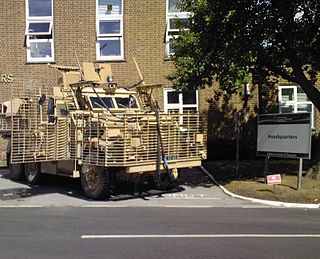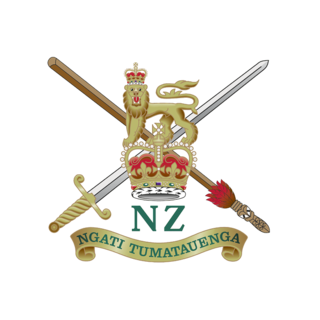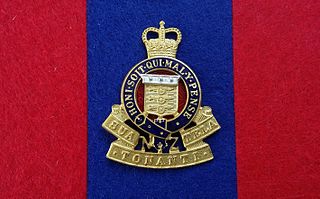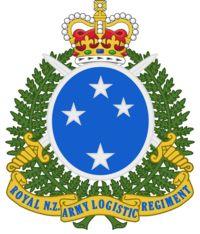This is the Operation Telic order of battle, which lists the British forces that took part in Operation Telic, including
Colonel-in-chief is a ceremonial position in a military regiment. It is in common use in several Commonwealth armies, where it is held by the regiment's patron, usually a member of the royal family.

The Royal Corps of Transport (RCT) was a British Army Corps established to manage all matters in relation to the transport of men and material for the Army and the wider Defence community. It was formed in 1965 and disbanded in 1993; its units and trades were amalgamated into the Royal Logistic Corps. The Depot and Training Regiment RCT was at the former Buller Barracks in Aldershot garrison.

The Corps of Royal Canadian Electrical and Mechanical Engineers (RCEME) is a personnel branch of the Canadian Armed Forces (CF) that provides army engineering maintenance support. All members of the corps wear army uniform. From the 1980s to 2013 it was called the Electrical and Mechanical Engineering Branch.
This is the Operation Herrick ground order of battle, which lists any British ground forces that have taken part in the duration of Operation Herrick between 2002 and 2014.
A Light Aid Detachment is an attached independent minor unit of the Royal Electrical and Mechanical Engineers, Royal Canadian Electrical and Mechanical Engineers, Royal Australian Electrical and Mechanical Engineers, or Royal New Zealand Army Logistic Regiment operating as a sub-unit of the supported unit. These units provide dedicated logistic support to every field unit of the Australian Army, British Army, Canadian Army or New Zealand Army. RAEME, REME, RCEME and the NZEME were created in October 1942 out of elements of the Royal Australian Army Ordnance Corps, Royal Army Ordnance Corps, Royal Engineers, Royal Corps of Signals, Royal Army Service Corps Royal Canadian Ordnance Corps and the New Zealand Ordnance Corps who previously handled functions such as the repair of weapons, optics and vehicles.

The Royal New Zealand Electrical and Mechanical Engineers (RNZEME) was a New Zealand Army Corps comprising Army trained tradesmen (craftsmen) who repaired Army equipment wherever New Zealand Forces served.
Army engineering maintenance consists of those engineers, technicians, and military organizations responsible for the expert repair and maintenance of army vehicles, weapon systems, and other equipment.

The Defence School of Transport (DST) Leconfield is located at Normandy Barracks, Leconfield near Beverley, East Riding of Yorkshire in England.

The Royal New Zealand Corps of Transport (RNZCT) was a corps within the New Zealand Army that provided logistical support to combat and combat support elements of the Army. Tracing its history back to 1910 when the New Zealand Army Service Corps (NZASC) was formed, as the RNZCT the corps was formed in 1979, when the NZASC was disbanded. Since 1979, the corps has been reorganised several times, undertaking a variety of roles before being subsumed into the Royal New Zealand Army Logistic Regiment in 1996.

This article describes the current structure of the New Zealand Army. It includes the army's order of battle and the headquarters locations of major units.
6 Regiment RLC is a regiment of the Royal Logistic Corps of the British Army.

The Royal New Zealand Army Ordnance Corps (RNZAOC) concerned itself with the provisioning of troops with the means to fight; specifically uniforms, weapons and equipment. Ordnance functions go back hundreds of years; the first Ordnance Officer in the British military appeared in the year 1299. Designated "Keeper of the King's Wardrobe", his duties included the care and accounting of heavy equipment such as battering rams and catapults.

New Zealand Force South East Asia (NZFORSEA) (1974–1989) comprised the elements of the Royal New Zealand Navy, New Zealand Army and Royal New Zealand Air Force. Much of the New Zealand military left Singapore as part of operation Kupe in 1989, leaving behind a residual Defence Support Unit (NZDSU).
The New Zealand Army contributed Royal New Zealand Army Ordnance Corps (RNZAOC) supply elements to the International and United Nations Operation in Somalia (UNOSOM) efforts in Somalia.
From four Stores Depots in the main centres of New Zealand at the beginning of the 20th century, the Royal New Zealand Army Ordnance Corps (RNZAOC) expanded and shrank to meet the operational needs of the NZ Army, Ordnance units have been deployed worldwide and across the breath and width of New Zealand.

The Special Operations Logistic Squadron (SOLS) is an independent and specialised unit of the Australian Army based in Sydney which provides specialist logistical support to all units of the Special Operations Command in support of special operations. It has developed a "jack of all trades" capability across military logistics including rapid prototyping and metal fabrication.
Logistic Specialist is the Royal New Zealand Army Logistic Regiment trade responsible for providing Supply & Quartermaster support to the New Zealand Army within New Zealand or overseas.
Future Soldier is a reform of the British Army resulting from the Integrated Review of Security, Defence, Development and Foreign Policy published in March 2021. The aim of the reform is to create a more lethal, agile and expeditionary force, able to fight and win wars and to operate in the grey-zone between peace and war. Future Soldier was published on 25 November 2021 and deals with the organizational changes of the British Army, with changes to personnel and equipment were set out in the Defence in a Competitive Age paper published on 22 March 2021.










